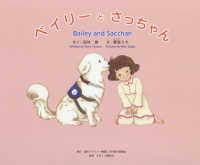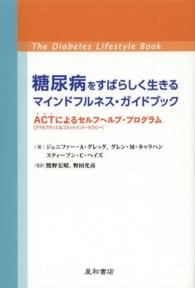- ホーム
- > 洋書
- > 英文書
- > History / World
Full Description
As East Asia regains its historical position as a world centre, information on the history of regional relations becomes ever more critical. Astonishingly, Northeast Asia enjoyed five centuries of international peace from 1400 to 1894, broken only by one major international war - the invasion of Korea in the 1590s by Japan's ruler Hideyoshi. This war involved Koreans, Japanese, Chinese, Southeast Asians, and Europeans; it saw the largest overseas landing in world history up to that time and devastated Korea. It also highlighted the nature of the strategic balance in the region, presenting China's Ming dynasty with a serious threat that perhaps foreshadowed the dynasty's subsequent overthrow by the Manchus, played a major part in the establishment of the Tokugawa regime with its policy of peace and controlled access to seventeenth- and eighteenth-century Japan, and demonstrated the importance for regional stability of the subtle relationship of Korea to both China and Japan. This book presents a comprehensive analysis of the war and its aftermath in all its aspects - military, political, social, economic, and cultural. As such it deepens understanding of East Asian international relations and provides important insights into the strategic concerns that continue to operate in the region at present.
Contents
Introduction Part 1: International and Domestic Background 1. The Relationship among China, Korea, and Japan in the Sixteenth Century 2. Korea's Domestic Situation and Relations with Japan on the Eve of the Imjin Waeran 3. Trade and Violence in Korean-Japanese Relations, 1510-1609 Part 2: Invasion 4. The Imjin Waeran: Contrasting the First and the Second Invasions of Korea 5. The Japan-Ming Negotiations and Hideyoshi's View of Chosŏn 6. Post-war Domain Source Material on Hideyoshi's invasion of Korea: The Wartime Memoirs of Shimazu Soldiers 7. Activities of the Chosŏn Navy and Progress of Important Naval Engagements during the Imjin Waeran (1592-98) 8. A Consideration of Guerrilla Resistance in the Imjin Waeran 9. A Korean War 10. Ming Grand Strategy and the Intervention in Korea 11. Wanli China: Rethinking China's Involvement in the Imjin Waeran 12. The Celestial Warriors: Military Aid and Abuse during the Korean War, 1592-98 Part 3: Impact and Memory 13. The Inestimable Benevolence of Saving a Country on the Brink of Ruin': Chosŏn-Ming and Chosŏn-Later Jin Relations in the Seventeenth Century 14. Chosŏn Korea and Ming China After the Imjin Waeran: State Rituals in the Later Chosŏn Period 15. War and Cultural Exchange 16. The Imjin Waeran in Korean and Japanese Literature17. Fashioning Womanly Confucian Virtue: The Virtuous Woman in Post-war Literary Discourse Conclusion







